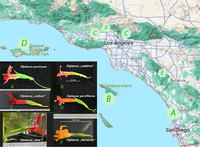HOME
This image shows the distribution of several Diplacus varieties that have red floral coloration. It's important to note that three inland species are not included in this image.
It seems that the Whole Genome Sequencing (WGS) for Diplacus "Catalina" and D. "ana" is still not available. Also, the Diplacus stellatus from Baja California on Cedros Island has a missing genome.


